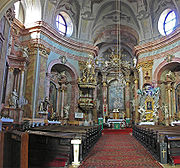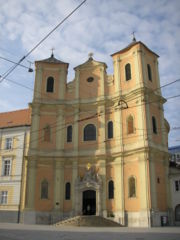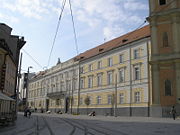
Trinitarian Church of Bratislava
Encyclopedia



Baroque architecture
Baroque architecture is a term used to describe the building style of the Baroque era, begun in late sixteenth century Italy, that took the Roman vocabulary of Renaissance architecture and used it in a new rhetorical and theatrical fashion, often to express the triumph of the Catholic Church and...
-style church in Bratislava
Bratislava
Bratislava is the capital of Slovakia and, with a population of about 431,000, also the country's largest city. Bratislava is in southwestern Slovakia on both banks of the Danube River. Bordering Austria and Hungary, it is the only national capital that borders two independent countries.Bratislava...
's Old Town
Old Town, Bratislava
The Old Town of Bratislava is the historic center and one of the boroughs of Bratislava, in the Bratislava Region of Slovakia. It is coextensive with the smallest Slovak administrative district by area, Bratislava I. It contains the small, but preserved medieval city center, Bratislava Castle and...
borough, on the Župné námestie square.
The church was built on the place of older Church of St. Michael, which was demolished in 1529, along with the settlement of St. Michael, during the Ottoman wars
Ottoman wars in Europe
The wars of the Ottoman Empire in Europe are also sometimes referred to as the Ottoman Wars or as Turkish Wars, particularly in older, European texts.- Rise :...
, along with other suburbs, so as to see better the attacking Turks. The Trinitarian Order
Trinitarian Order
The Order of the Holy Trinity is a Catholic religious order that was founded in the area of Cerfroid, some 80 km northeast of Paris, at the end of the twelfth century. The founder was St. John de Matha, whose feast day is celebrated on 17 December...
started construction of the church in 1717 and it was sanctified in 1727, although the works in the interior continued to the first half of the 18th century.
Description
The design is thought to be copied from the St. Peter's ChurchPeterskirche, Vienna
St. Peter's Church is a Baroque Roman Catholic parish church in Vienna, Austria. It was transferred in 1970 by the Archbishop of Vienna Franz Cardinal König to the priests of the Opus Dei.-The first church:...
in Vienna
Vienna
Vienna is the capital and largest city of the Republic of Austria and one of the nine states of Austria. Vienna is Austria's primary city, with a population of about 1.723 million , and is by far the largest city in Austria, as well as its cultural, economic, and political centre...
. The arch is dominated by a cupola
Cupola
In architecture, a cupola is a small, most-often dome-like, structure on top of a building. Often used to provide a lookout or to admit light and air, it usually crowns a larger roof or dome....
with trompe-l'œil fresco
Fresco
Fresco is any of several related mural painting types, executed on plaster on walls or ceilings. The word fresco comes from the Greek word affresca which derives from the Latin word for "fresh". Frescoes first developed in the ancient world and continued to be popular through the Renaissance...
from Italian Baroque painter Antonio Galli Bibiena. The massive main altar
Altar
An altar is any structure upon which offerings such as sacrifices are made for religious purposes. Altars are usually found at shrines, and they can be located in temples, churches and other places of worship...
of the church was presumably built by A. G. Bussi. Its main work of art is an altarpiece
Altarpiece
An altarpiece is a picture or relief representing a religious subject and suspended in a frame behind the altar of a church. The altarpiece is often made up of two or more separate panels created using a technique known as panel painting. It is then called a diptych, triptych or polyptych for two,...
depicting St. John of Matha
John of Matha
Saint John of Matha was a Christian saint of the 12th century and founder of the Order of the Most Holy Trinity. He was born on 1154 at Faucon-de-Barcelonnette, France. As a youth, he was educated at Aix-en-Provence, and later studied theology at the University of Paris...
and St. Felix of Valois ransoming prisoners from Turkish capture. Statues of St. Agnes
Saint Agnes
Agnes of Rome is a virgin–martyr, venerated as a saint in the Roman Catholic Church, Eastern Orthodox Church, the Anglican Communion, and Lutheranism. She is one of seven women, excluding the Blessed Virgin, commemorated by name in the Canon of the Mass...
and St. Catherine
St. Catherine
-People:*Saint Catherine of Alexandria , also known as Saint Catherine of the Wheel and The Great Martyr Saint Catherine*Saint Caterina Volpicelli *Saint Catherine of Bologna *Saint Catherine of Genoa...
situated in the rear of the main altar are attributed to the Bavarian sculptor Johann Baptist Straub
Johann Baptist Straub
Johann Baptist Straub was a German Rococo sculptor.-Biography:Straub was born in Wiesensteig, into a family of sculptors. His father Johann George Straub and his brothers Philipp Jakob, Joseph, and Johann Georg Straub were also sculptors, as was his nephew Franz Xaver Messerschmidt. J. B...
. The rear altar of the Virgin Mary
Mary (mother of Jesus)
Mary , commonly referred to as "Saint Mary", "Mother Mary", the "Virgin Mary", the "Blessed Virgin Mary", or "Mary, Mother of God", was a Jewish woman of Nazareth in Galilee...
was built in 1736 on the order of the Count Zichy
Zichy
Zichy , the name of a noble Magyar family, conspicuous in Hungarian history from the latter part of the 13th century onwards.-Brief history of the Zichy:...
. This altar has a copy of the Regensburg
Regensburg
Regensburg is a city in Bavaria, Germany, located at the confluence of the Danube and Regen rivers, at the northernmost bend in the Danube. To the east lies the Bavarian Forest. Regensburg is the capital of the Bavarian administrative region Upper Palatinate...
painting of Madonna. The main portal is richly decorated in Rococo
Rococo
Rococo , also referred to as "Late Baroque", is an 18th-century style which developed as Baroque artists gave up their symmetry and became increasingly ornate, florid, and playful...
style, celebrating the Holy Trinity.
History
At the time of sanctifying of the church, a TrinitarianTrinitarian Order
The Order of the Holy Trinity is a Catholic religious order that was founded in the area of Cerfroid, some 80 km northeast of Paris, at the end of the twelfth century. The founder was St. John de Matha, whose feast day is celebrated on 17 December...
monastery was built on the place of nearby cemetery. However, the Trinitarian Order was closed by Joseph II
Joseph II, Holy Roman Emperor
Joseph II was Holy Roman Emperor from 1765 to 1790 and ruler of the Habsburg lands from 1780 to 1790. He was the eldest son of Empress Maria Theresa and her husband, Francis I...
in 1782 and the comitatus (county) office gained the building. However, it wasn't suiting its needs and was almost wholly demolished; "County House/Building" (Slovak: Župný dom, Hungarian: Vármegyeháza) was built in 1844 in its place and became the seat of the Pressburg county. In the Great Hall of the building there were concerts of various composers, for example of Franz Liszt
Franz Liszt
Franz Liszt ; ), was a 19th-century Hungarian composer, pianist, conductor, and teacher.Liszt became renowned in Europe during the nineteenth century for his virtuosic skill as a pianist. He was said by his contemporaries to have been the most technically advanced pianist of his age...
or Johannes Brahms
Johannes Brahms
Johannes Brahms was a German composer and pianist, and one of the leading musicians of the Romantic period. Born in Hamburg, Brahms spent much of his professional life in Vienna, Austria, where he was a leader of the musical scene...
. From 1939 to 1994 Slovak National Council
Slovak National Council
The Slovak National Council is the name of different types of supreme bodies in the history of Slovakia. They existed within the Kingdom of Hungary, Czechoslovakia or the Slovak Republic or were bodies of Slovak exiles:...
s (since 1992 National Council of the Slovak Republic
National Council of the Slovak Republic
The National Council of the Slovak Republic , abbreviated to NR SR, is the national parliament of Slovakia. It is unicameral, and consists of 150 MPs, who are elected by universal suffrage under proportional representation every four years....
) were housed in the building until the seat was moved into a new building next to the Bratislava Castle
Bratislava Castle
Bratislava Castle is the main castle of Bratislava, the capital of Slovakia.The massive rectangular building with four corner towers stands on a quite isolated rocky hill of the Little Carpathians directly above the Danube river in the middle of Bratislava...
. Some of the notable political events include Tiso's
Jozef Tiso
Jozef Tiso was a Slovak Roman Catholic priest, politician of the Slovak People's Party, and Nazi collaborator. Between 1939 and 1945, Tiso was the head of the Slovak State, a satellite state of Nazi Germany...
government declaration of independent Slovakia on 14 March 1939 or the passing of the independence declaration
Slovak National Council's Declaration of Independence of the Slovak Nation
The Slovak National Council's Declaration of Independence of the Slovak Nation was a resolution of the Slovak National Council on 17 July 1992, by which members of the Council demanded Slovakia's independence...
on 17 July 1992.
From 2003 to 2009, the church was the cathedral of the Military Ordinariate of Slovakia
Military Ordinariate of Slovakia
The Military Ordinariate of Slovakia is a military ordinariate of the Roman Catholic Church. Immediately subject to the Holy See, it provides pastoral care to Roman Catholics serving in the Slovakian Armed Forces and their families.-History:...
.

